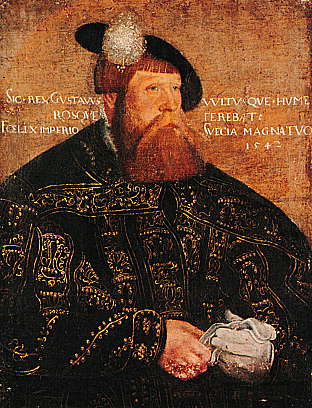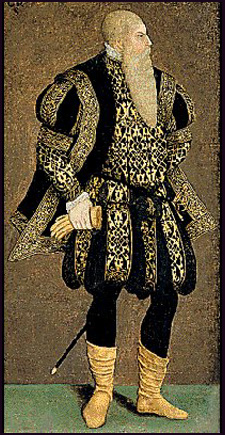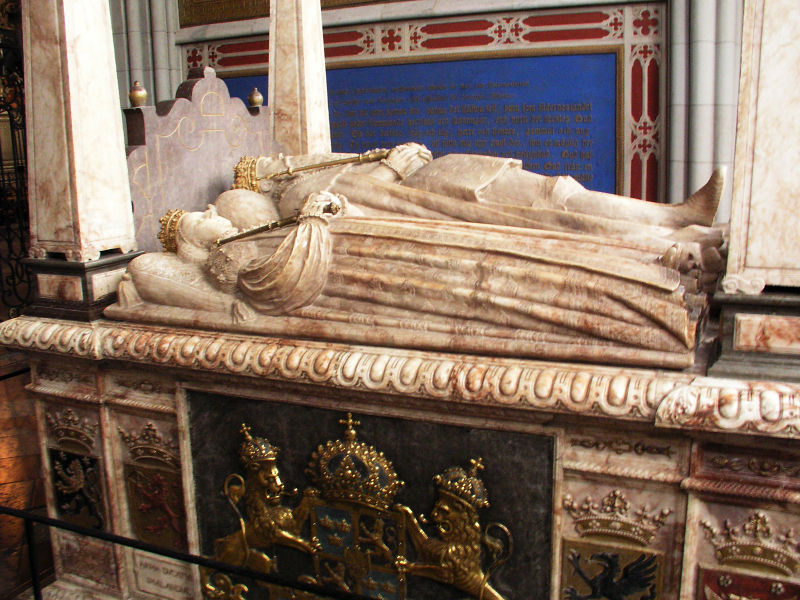<Back to Index>
- Pediatrician Clemens Peter von Pirquet, 1874
- Composer Gabriel Urbain Fauré, 1845
- King of Sweden Gustav I Vasa, 1496
PAGE SPONSOR


Gustav I of Sweden, born Gustav Eriksson (Colloquial 15th century Upplandic, Gösta Jerksson) and later known as Gustav Vasa (12 May 1496 – 29 September 1560), was King of Sweden from 1523 until his death. He was the first monarch of the House of Vasa, an influential noble family which came to be the royal house of Sweden for much of the 16th and 17th centuries. Gustav I was elected regent in 1521 after leading a rebellion against Christian II of Denmark, the leader of the Kalmar Union who controlled most of Sweden at the time.
Gustav
was an enigmatic person who has been referred to as both a liberator of
the country and as a tyrannical ruler. When he came to power in 1523,
he was largely unknown, and he became the ruler of a still divided
country without a central government. He became the first truly autocratic native Swedish sovereign
and was a skilled propagandist and bureaucrat who laid the foundations
for a more efficient centralized government. During his reign Protestantism was introduced in the
country. In
traditional Swedish history he has been labelled the founder of modern
Sweden, and the "father
of
the nation". Gustav liked to compare himself to Moses,
whom
he believed to have also liberated his people and established a
state. As a person, Gustav was known for ruthless methods and a bad
temperament, but he also loved music, and had a certain sly wit. Gustav
Eriksson's (Vasa) mother was Cecilia
Månsdotter and
father
was Erik
Johansson (Vasa)
who
descended from Birgitta Gustafsdotter (Sture), the sister of
childless Regent Sten
Sture
the Elder who
had died in 1503 when Gustav was a child. According to genealogical
research, Birgitta and Sten Sture (and consequently also Gustav Vasa)
descended from King Sverker
II
of Sweden, through King Sverker's granddaughter Benedikte
Sunesdotter (who was married to Svantepolk Knutsson, son of Duke of
Reval). Gustav was born in Rydboholm
Castle. The Vasa family belonged to the highest level of hereditary
Swedish nobility (högfrälse) and they possessed some
wealth: several manors etc. Like most Swedes at
the time, he used no family name and was originally known by his given
name and patronymic, but
the name of the dynasty, derived from the main heraldic charge of
the family, has often been given to him by later authors. Gustav
Vasa's father, Erik
Johansson (Vasa),
was
involved in the party of Sten
Sture
the Younger fighting
against
the Danes in the early 16th century. When the Danes, under
Christian II, conquered Sweden and took the capital Stockholm in 1520
several members of the Sture party were executed in the Stockholm
Bloodbath in
October that year, among whom was Erik Johansson. The young Gustav survived by hiding. He got
involved in some of the revolts against the Danish king. At the battle
of Brännkyrka on 2 October 1518, he was
among those captured and taken prisoner. He was held in Kalø
slot but managed to
escape, returning by ship to Kalmar on the southeastern side of
Sweden on 31 May 1520. From there, he travelled all the way up to the
province of Dalarna,
in
what was then northwestern Sweden. He tried to gather troops to take
down the Danish government, but had little success initially. According
to popular history, as depicted in 19th century Swedish schoolbooks,
Gustav encountered many adventures while he was fleeing around Dalarna.
Their historical validity is questioned, however. In 1521
he had managed to gather a small army in Dalarna and become its leader.
He also received help by troops from Leipzig,
Germany.
By August 1521, the men of Dalarna had elected him regent of
Sweden; two
years
of war followed,
whereby the Danish troops were gradually defeated.
Gustav
was elected king on 6 June 1523, at the riksdag in Strängnäs.
This
date has later been celebrated as the Swedish national
holiday (Gustav was
later crowned in Uppsala
Cathedral on 21
January 1528). His troops had besieged the capital, and on 24 June,
they finally could march into Stockholm. The country was however in no
way united in support of the king at that time. After
Gustav seized power, the previous Archbishop, Gustav
Trolle, who at the time held the post of a sort of chancellor, was
exiled from the country. Gustav sent a message to the Pope requesting
the acceptance of a new archbishop selected by Gustav himself: Johannes
Magnus. The Pope
sent back his decision demanding that unlawful expulsion of Archbishop
Gustav Trolle be rescinded, and that the archbishop be reinstated. Here
Sweden's remote geographical location proved to have a marked impact —
for the former Archbishop had been allied with the Danish king, or at
least was considered to have been so allied in contemporary Stockholm,
and to reinstate him would be close to impossible for Gustav. The king
let the Pope know the impossibility of the request, and the possible
results if the Pope persisted, but — for better or worse — the Pope did
persist, and refused to accept the king's suggestions of archbishops.
At the time, incidentally and for different reasons, there were also
four other unoccupied bishop's seats, where the king made suggestions
to the Pope about candidates, but the Pope only accepted one of the
candidates. Because the Pope refused to budge on the issue of Gustav
Trolle, the king, influenced by Lutheran scholar Olaus
Petri, in 1531 took it upon himself to appoint yet another
archbishop, namely the brother of Olaus, Laurentius
Petri. With this royal act, the Pope lost any influence over the
Swedish Church.
In the
1520s, the Petri brothers led a campaign for the introduction of Lutheranism.
The
decade saw many events which can be seen as gradual introductions of Protestantism,
for
instance the marriage of Olaus Petri — a consecrated priest — and
several texts published by him, advocating Lutheran dogmas. A
translation of the New
Testament had also
been published in 1526. After the reformation, a full translation was
published in 1540-41, called the Gustav
Vasa
Bible. However, knowledge of Greek and Hebrew among Swedish
clergymen was not sufficient for a translation from the original
sources; instead the work followed the German translation by Martin
Luther in 1534. Gustav
I's breaking with the Catholic Church is virtually simultaneous with Henry
VIII doing the same
in England; both kings acted following a similar pattern, i.e., a
prolonged confrontation with the Pope culminating with the king
deciding to take his own decisions independently of Rome. Gustav
encountered resistance from some areas of the country. People from Dalarna rebelled
three
times in the first ten years of Gustav's reign, as they
considered the king to have been too harsh on everyone he perceived as
a supporter of the Danish, and as they resented his introduction of
Protestantism. Many of those who had helped Gustav in his war against
the Danes became involved in these rebellions and paid for this,
several of them with their lives.
People in Småland rebelled in 1542, and
initially gave Gustav severe difficulties in the dense forests. The
king sent a letter to the people of Dalarna, requesting that they
should send out letters to every Swedish province, stating that Dalarna
would support the king with troops, and urging every other province to
do the same. Gustav got his troops, with whose help - and paid German
mercenaries - he managed to defeat the rebels next spring. The
leader of the rebels, Nils
Dacke, has traditionally been seen as a traitor to Sweden. His own letters
and proclamations to fellow peasants focused on the suppression of
Roman Catholic customs of piety, the King's requisitions of church
bells and church plate to be smelted down for money and the general
discontent with Gustav's autocratic measures, and the King's letters
indicate that Dacke had considerable military success for several
months. Historical records state that Nils was seriously wounded during
a battle, taking bullet wounds to both legs; if this is true, his
survival may have been surprising in view of contemporary medical techniques. Some sources state that Nils was executed by quartering; others that he was reduced
to the state of an outlaw after recovering from his wounds, and killed
while trying to escape through the woods on the border between Småland and then Danish Blekinge. It
is said that his body parts were displayed throughout Sweden as a
warning to other would-be rebels; this is uncertain though his head was
likely mounted on a pole at Kalmar.
Modern
Swedish scholarship has toned down criticism of Nils Dacke,
sometimes making him into a hero in the vein of Robin
Hood, particularly in Småland. Difficulties
with
the continuation of the Church also troubled Gustav Vasa. The
1540s saw him imposing death sentences upon both the Petri brothers, as
well as his former chancellor Laurentius
Andreae. All of them were however granted amnesty, after spending
several months in jail. In 1554 – 1557, he waged an
inconclusive
war against Ivan
the
Terrible of Russia. In the
late 1550s, Gustav's health declined. When his grave was opened in
1945, an examination of his corpse revealed that he had suffered chronic infections of a leg and in his jaw. He gave a
so-called "last speech" in 1560 to the chancellors, his children and
other noblemen, whereby he encouraged them to remain united. On 29
September 1560, Gustav died and was buried (together with three of his
wives, while only two are engraved) in the Cathedral
of
Uppsala.
Gustav's
heritage
has been disputed. In 19th century Swedish history a folklore
developed wherein Gustav was supposed to have had all kinds of
adventures when he liberated Sweden from the Danes. The memory of
Gustav has been honored greatly, resulting in embroidered history books, commemorative
coins, and the annual ski event Vasaloppet (the largest ski event in
the world with 15,000 participants). The city of Vaasa in Finland was named after the royal
house of Vasa in 1606. Gustav is currently portrayed on the 1000 kronor note. Today most of these
stories are considered to have no other foundation than legend and
skilful propaganda by Gustav himself during his time. Here is
an example of one of his better known adventures among the Swedish
people. While Gustav was in exile from the Danish army, he was staying
at a farm owned by a close friend for a day's rest. As he was warming
himself in the common room, the Danish soldiers got a tip from one of
the farm hands that Gustav was in his landlord's farm house. The Danish
soldiers burst into the farm house and began searching in the common
room for someone that would fit Gustav's description. As one of the
soldiers came close to check Gustav Vasa, all of a sudden the landlady
took out a bakery spade and started to hit Gustav and scolded him as a
"lazy farmboy" and ordered him to go out and work. The Danish soldier
found it amusing and didn't realise this "lazy farmboy" was in fact
Gustav Vasa himself who managed to slip away from danger and escape
death. There are many other stories about Gustav's close encounters
with death, however it is questionable if any of his adventures really
did happen or were dramatised by Gustav himself; regardless of whether
they happened or not, his adventures are still told to this day in
Sweden. Gustav
has been regarded by some as a power-hungry man who wished to control
everything: the Church, the economy, the army and all foreign affairs.
But in doing this, he also did manage to unite Sweden, a country that
previously had no standardised language, and where individual provinces
held a strong regional power. He also laid the foundation for Sweden's
professional army that was to make Sweden into a regional superpower in
the 17th century.
